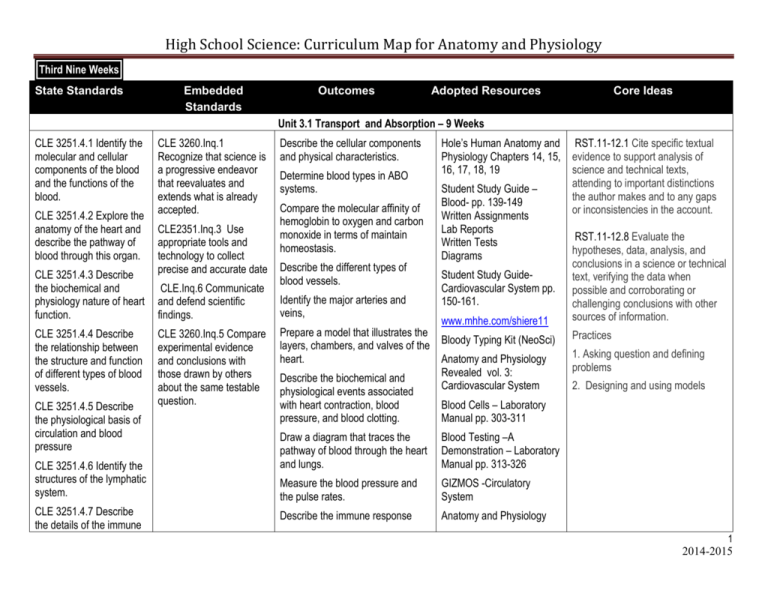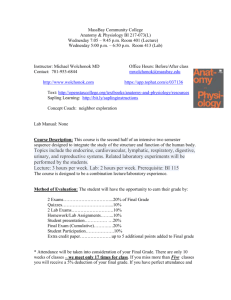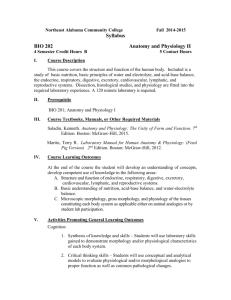High School Science: Curriculum Map for Anatomy and Physiology
advertisement

High School Science: Curriculum Map for Anatomy and Physiology Third Nine Weeks State Standards Embedded Standards Outcomes Adopted Resources Core Ideas Unit 3.1 Transport and Absorption – 9 Weeks CLE 3251.4.1 Identify the molecular and cellular components of the blood and the functions of the blood. CLE 3251.4.2 Explore the anatomy of the heart and describe the pathway of blood through this organ. CLE 3251.4.3 Describe the biochemical and physiology nature of heart function. CLE 3251.4.4 Describe the relationship between the structure and function of different types of blood vessels. CLE 3251.4.5 Describe the physiological basis of circulation and blood pressure CLE 3251.4.6 Identify the structures of the lymphatic system. CLE 3251.4.7 Describe the details of the immune CLE 3260.Inq.1 Recognize that science is a progressive endeavor that reevaluates and extends what is already accepted. CLE2351.Inq.3 Use appropriate tools and technology to collect precise and accurate date CLE.Inq.6 Communicate and defend scientific findings. CLE 3260.Inq.5 Compare experimental evidence and conclusions with those drawn by others about the same testable question. Describe the cellular components and physical characteristics. Determine blood types in ABO systems. Compare the molecular affinity of hemoglobin to oxygen and carbon monoxide in terms of maintain homeostasis. Describe the different types of blood vessels. Identify the major arteries and veins, Hole’s Human Anatomy and RST.11-12.1 Cite specific textual Physiology Chapters 14, 15, evidence to support analysis of 16, 17, 18, 19 science and technical texts, attending to important distinctions Student Study Guide – the author makes and to any gaps Blood- pp. 139-149 or inconsistencies in the account. Written Assignments Lab Reports Written Tests Diagrams Student Study GuideCardiovascular System pp. 150-161. www.mhhe.com/shiere11 Prepare a model that illustrates the layers, chambers, and valves of the Bloody Typing Kit (NeoSci) heart. Anatomy and Physiology Revealed vol. 3: Describe the biochemical and Cardiovascular System physiological events associated with heart contraction, blood pressure, and blood clotting. Blood Cells – Laboratory Manual pp. 303-311 Draw a diagram that traces the pathway of blood through the heart and lungs. Blood Testing –A Demonstration – Laboratory Manual pp. 313-326 Measure the blood pressure and the pulse rates. GIZMOS -Circulatory System Describe the immune response Anatomy and Physiology RST.11-12.8 Evaluate the hypotheses, data, analysis, and conclusions in a science or technical text, verifying the data when possible and corroborating or challenging conclusions with other sources of information. Practices 1. Asking question and defining problems 2. Designing and using models 1 2014-2015 High School Science: Curriculum Map for Anatomy and Physiology Third Nine Weeks response. CLE3251.5.1 Identify organs of the digestive system and describe their functions. CLE3251.5.2 Investigate mechanisms of digestion and food absorption. mechanisms of at the cellular level. Relate nonspecific cellular and chemical defenses of the body to environmental factors. Revealed vol. 3: Cardiovascular System Heart Attack Video www.unitedstreaming.com Heart Structure Identify the causes of imbalances :Laboratory Manual – pp. in the immune system. 327-335 Locate the six major areas of lymph Cardiac Cycle – Laboratory nodes and identify the lymphatic Manual – pp. 337-343 system components. Pulse Rate and Blood Compare the structure and function Pressure Laboratory Manual pp. 353of organs in the digestive system. 356 Trace a selected food through the Student Study Guidealimentary canal. Lymphatic System pp. 162Explain how the products of 173. digestion are absorbed. Physiology Chapter 16 www.mhhe.com/shiere11 Anatomy and Physiology Revealed vol. 3: Lymphatic System Lymphatic System – Laboratory Manual – pp. 385-390 GIZMOS - Disease Spread Virus Lytic Cycle Heart Structure :Laboratory Manual – pp. 327-335 2 2014-2015 High School Science: Curriculum Map for Anatomy and Physiology Third Nine Weeks Cardiac Cycle – Laboratory Manual – pp. 337-343 Pulse Rate and Blood Pressure Laboratory Manual pp. 353356 TOOLBOX 3 2014-2015 High School Science: Curriculum Map for Anatomy and Physiology Third Nine Weeks TOOLBOX Unit 3.1 Transport Plans Blood http://www.biologycorner.com/anatomy/blood/notes_blood.html Blood Concept http://www.biologycorner.com/anatomy/blood/blood_concept_map.html Blood Disorders http://www.biologycorner.com/anatomy/blood/notes_blood_disorders.html Blood Typing http://www.biologycorner.com/anatomy/blood/notes_bloodtype.html The Circulatory System http://www.biologycorner.com/anatomy/circulatory/notes_ch13_cardiovascular.html Heart Actions http://www.biologycorner.com/anatomy/circulatory/notes_ch13_cardiac_cycle.html Digestive System http://www.biologycorner.com/anatomy/digestive/notes_digestive.html Gulp (Don’t Gag): Modeling the Complexity of the Digestive System http://learning.blogs.nytimes.com/2013/05/01/gulp-dont-gag-modeling-the-complexity-of-the-digestive-system/ The Respiratory System http://www.biologycorner.com/anatomy/respiratory/notes_respiratory_system.html Article: Everest/First Ascents: Altitude Danger Begins in Pheriche http://www.backpacker.com/everest_first_ascent/blogs/daily_dirt/910 Unit 3.1 Cardiac Risk in the Young (CRY) 4 2014-2015 High School Science: Curriculum Map for Anatomy and Physiology Third Nine Weeks TOOLBOX http://www.c-r-y.org.uk/cardiac_tests.htm Transport Background for Teachers Your Digestive System and How It Works http://digestive.niddk.nih.gov/ddiseases/pubs/yrdd/ The Digestive System http://www.emc.maricopa.edu/faculty/farabee/biobk/biobookdigest.html Human Digestive System http://www.enchantedlearning.com/subjects/anatomy/digestive/ Digestive System http://www.innerbody.com/image/digeov.html How the Respiratory System Works http://www.nhlbi.nih.gov/health/health-topics/topics/hlw/system.html Unit 3.1 Genetics of Blood Disorders http://www.biologycorner.com/anatomy/blood/blood_disorder_genetics.html Transport Student Activities Blood Typing (Use Simulated Blood) http://www.biologycorner.com/anatomy/blood/blood_typing_lab.html Label the Digestive System http://www.biologycorner.com/anatomy/digestive/digestive_labeling.html Digestive System concept Map http://www.biologycorner.com/anatomy/digestive/digestive_concept_map.html Digestive System Study Guide http://www.biologycorner.com/anatomy/digestive/study_guide_digestive.html Respiratory System Study Guide 5 2014-2015 High School Science: Curriculum Map for Anatomy and Physiology Third Nine Weeks TOOLBOX http://www.biologycorner.com/anatomy/respiratory/review_ch16.html Measuring Blood Pressure http://www.biologycorner.com/worksheets/measuring_blood_pressure.html Unit 3.1 Transport Circulatory System Review http://www.biologycorner.com/anatomy/circulatory/review_guide.html Presentation Slides of the Human Vessels Other Resources https://docs.google.com/presentation/d/1e_CgGdQy61dYw3Y-lhvXK921WXbvzEhSf-f__7h2KhU/present#slide=id.i0 Virtual Anatomy Textbook: The Digestive System http://www.acm.uiuc.edu/sigbio/project/digestive/ 6 2014-2015







